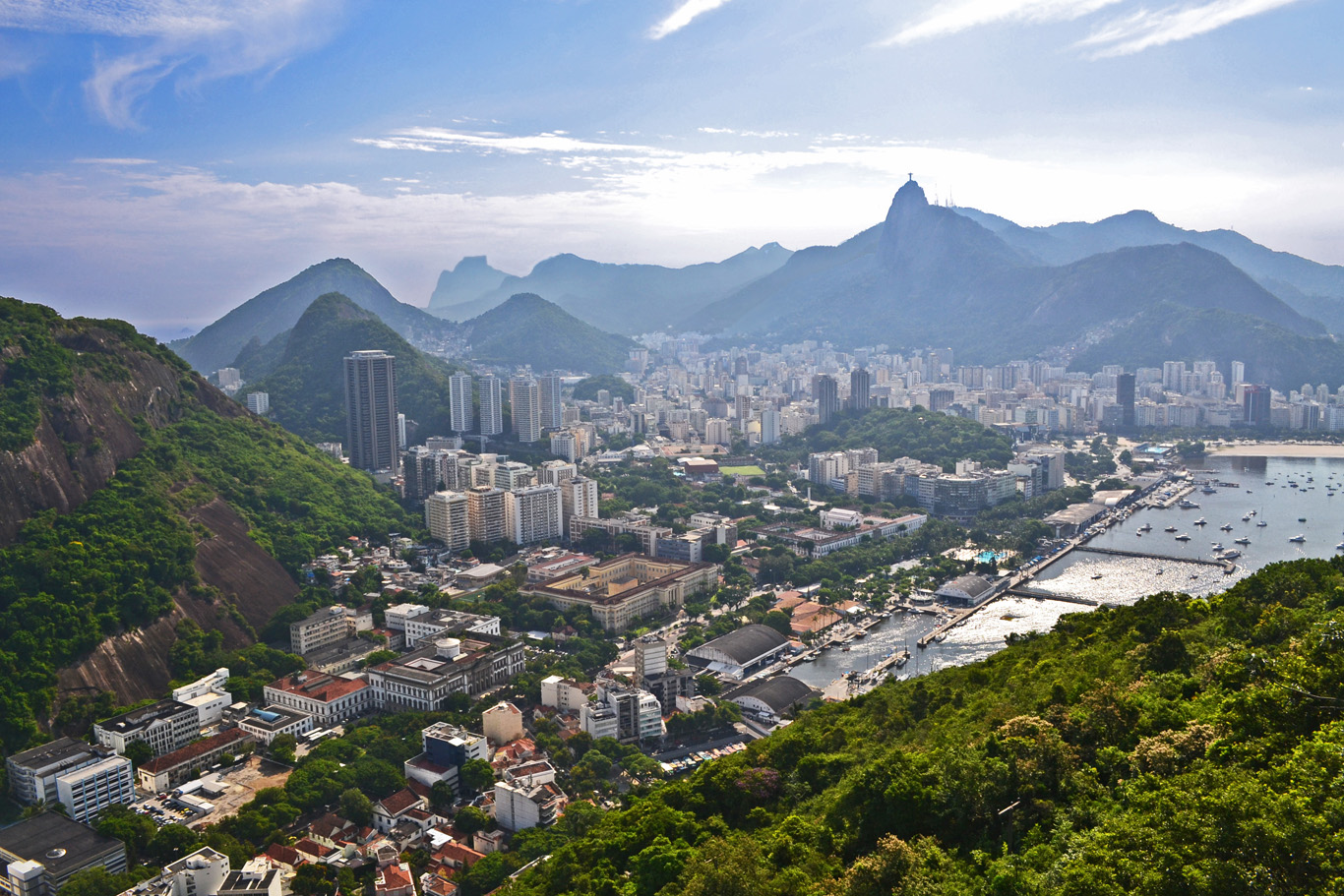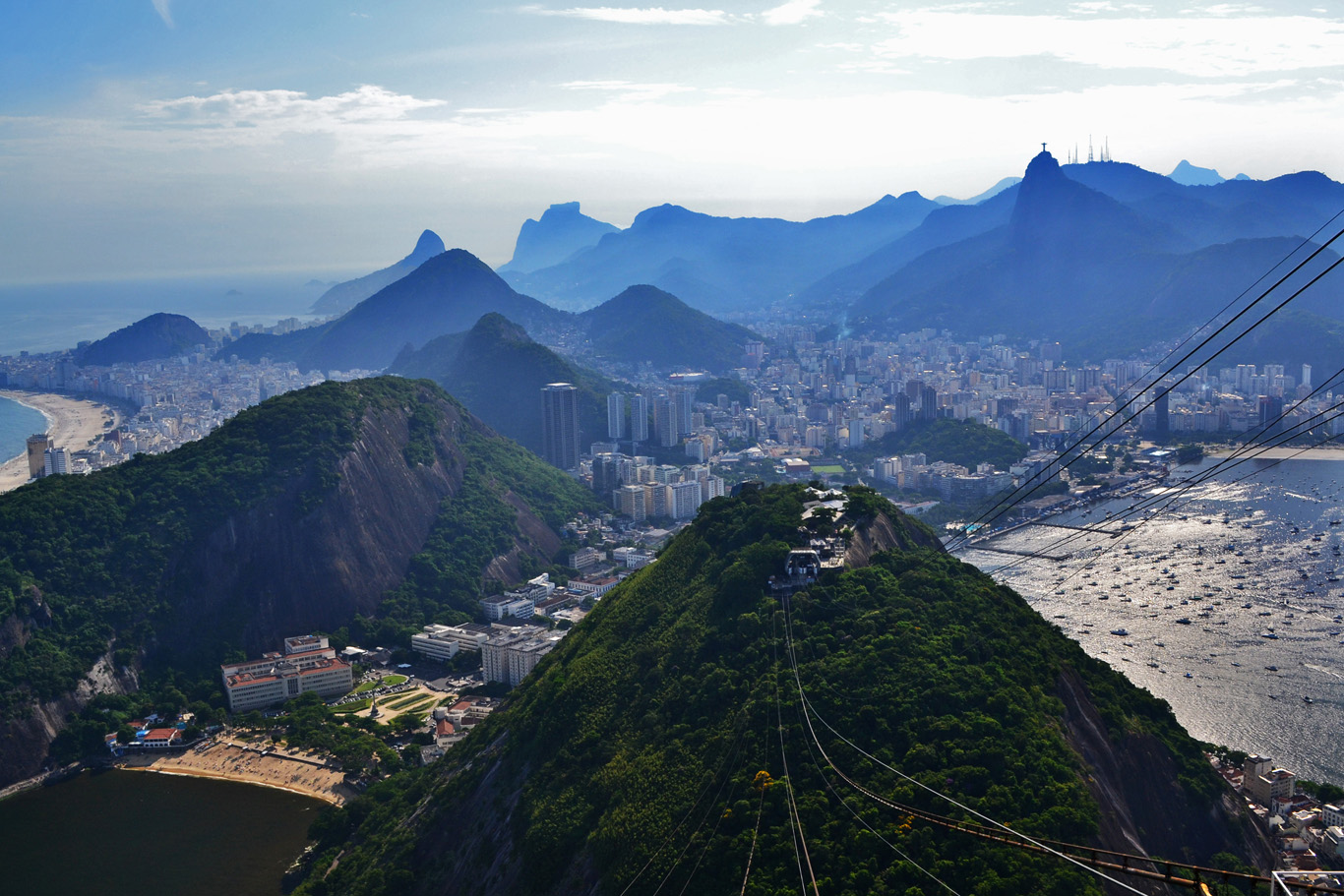Rio de Janeiro is known in Brazil as "Cidade Maravilhosa" - the wonderful city. Without any doubt it is wonderful. The introduction is probably unnecessary as Rio is one of the best known cities in the world. I had only three days to visit this city and for sure it wasn't enough. But anyway, I had a chance to take a glimpse of the most important places a visitor should see. And it was a great experience.
However, my first impression after arriving at Rio de Janeiro International Airport was a surprise that the terminal was so small. It reminded more of a domestic airport rather than international one. For such a famous place, I had expected something much bigger. There is one little coffee shop, and even in the departure terminal there is only a cafe - bar and a few shops with souvenirs at astronomical prices.
After quite a long wait at the passport control (airport staff in Brazil check all the passports very carefully) I took a bus to the city center for about 15 BRL (6 EUR or 7.5 USD). Taxi costs around 60-70 BRL (23-27 EUR, 30-35 USD) as the city centre is quite far from the airport.
Rio after dark - view from Corcovado hill
View from the Sugar Loaf
Rio de Janeiro and Sugar Loaf mountain
In contrast to the international airport, the city itself is truly amazing. Rio's beauty lies mainly in its location. Situated among pointy hills covered in rain forests and the sea with the famous, white sand beaches, it's a great destination for all types of holiday activities: from lazy days at the seaside to hiking the hills, strolling through the botanical gardens and the Tijuca forest where the Corcovado hill with the statue of Christ is also located.
The famous statue of Christ
Bear in mind that Rio de Janeiro, especially during the carnival season, is not a cheap destination. Budget accommodation is usually quite expensive as well as prices of food, taxis etc. I paid 75 BRL (30 EUR, 37 USD) per person per night for a tiny room for 3 people in a very basic hostel. In many places in Europe (except the most expensive Scandinavian countries) you can get better quality accommodation for half as much.
View from Sugar Loaf mountain
Cable car station in Rio
Rio de Janeiro top attractions
Day 1:
Sugar Loaf Mountain and the statue of Christ
Sugar Loaf Mountain
Needles to say, Sugar Loaf, besides the statue of Christ is one of the main attractions in Rio. The hill is 395 meters (1296 feet) high and it's connected with a cable car that has been operating since 1912. It can take up to 65 passengers at once to the top. It is open for tourists from 8 am until 7.30 pm. Return journey costs 53 BRL (20 EUR or 26 USD) for an adult and 26 BRL (10 EUR or 13 USD) for a student. Children under 6 years of age travel for free. On top of the hill there's an exhibition about the history of the cable car, a few cafes, restaurants and souvenir shops. But the most incredible attraction of the place is the nature itself, the breathtaking views over the cost, beaches and other pointy hills of Rio. The city, integrated into this diverse terrain looks astonishing and no wonder the view from the mountain is one of the most popular views in the world.
View from the Sugar Loaf
Statue of Christ the Redeemer
Statue of Christ is the most known trademark of Rio de Janeiro. Standing on the 710 meters (2329 feet) above sea level Corcovado hill, it looks down over the city and the coast. And the view it sees is truly amazing, just like from the Sugar Loaf mountain but in the opposite direction. It is worth to be on top of the hill at the sunset so that you can admire Rio's lights after dark. The statue itself is around 34 meters (100 feet) tall. There are a couple of ways of getting to the top of the hill. The most popular is the tram near Rua Cosme Velho. It's the quickest and most convenient way. Tram leaves the station every half an hour from 8.30 am until 7 pm. The journey to the statue takes around 25 minutes. It's better to take a sear on the left hand side of the tram, this way you will get the best views. The return adult ticket costs 43 BRL (16 EUR or 21 USD), student - 21,50 BRL (8 EUR or 11 USD). You can also reach the peak by car or by taxi, this is the most comfortable and the quickest way. The last and most adventurous option is to climb the hill, there are a few nice trails through Tijuca forest. Unfortunately, even then you will have to pay to enter the viewing platform - 12 BRL (4,5 EUR or 6 USD).
It is easily doable to visit both places, Sugar Loaf mountain and the Statue of Christ in one day. They are not far away from each other and it only takes a short taxi ride from the one place to the other.
Rio de Janeiro
Statue od Christ seen from the center of Rio
Day 2:
Rio De Janeiro Botanical Garden - Jardim Botanico
If you are getting tired of the ubiquitous crowds of people in Rio, you might want to look for peace and silence in the Botanical Garden. It's situated right at the foot of the Corcovado hill and it's not as crowded with tourists as the city and its beaches. You can get there easily by public transport, bus number 124 goes there from Copacabana, Ipanema and Leblon. A taxi ride from the city won't be too long or expensive either. It is open from 8 am until 5 pm. The entry fee is around 6 BRL (2 EUR or 3 USD). The garden was founded in 1808 by John VI of Portugal.
Botanic gardens - the avenue of royal palms
Statue of Christ seen from botanic gardens
The most prominent part of the Gardens is the 750 meters (2460 feet) long Avenue of royal palms, with more than 130 trees, that leads you from the entrance to the gardens. There are more than 6000 species of tropical plants here, many brought from India, as well as numerous greenhouses, ponds and alleys. A large part of the area consists of the original rain forest that stretches up to the slopes of Corcovado. The Jardim Botanico in Rio can also boast with a large number of bird, butterfly and monkey species. The monkeys are cute, roam around freely and tourists always feed them but be careful because they can 'steal' some small things like sunglasses.
Botanic gardens
Monkeys in the gardens
Day 3:
Tijuca Forest - Floresta da Tijuca
Tijuca Forest in Rio de Janeiro is the largest urban forest in the world. It contains the famous Corcovado hill with the statue of Christ and the Tijuca peak - 1020 meters above sea level (3346 feet) which is yet another great viewpoint for admiring Rio and its vicinity from a bird's eye perspective. Getting to Ticuja Forest from Rio is not expensive or difficult. If you want to save some cash, you travel by metro to the station Saens Pena. From there, you take a bus, number 233, that goes to Alta Boa Vista. The ride on the bus takes around 35 minutes.
Tunay waterfall in Tijuca forest
Favela on a hill in Tijuca forest
Very close to the entrance, there is a 30-meter (100 feet) waterfall called Tunay. From there you can choose from a couple of trails. The most worth to follow is the one that leads to the Tijuca peak - but you must be prepared for 2-3 hour climb. There are various tour operators that offer tours to Tijuca forest. But if you organize it yourself, you will pay five to ten times less.
Favela in Rio
Cable car for Sugar Loaf mountain
If you liked this article, you can also download it via the GPSmyCity app - you will be able to gain access to the guide, which will direct you to all the attractions described above, even if you're offline. Download it here.
Related Posts
Copying without permission is not allowed. If you wish to use any of the site's content (photos or text) or work with us, please contact us.
We welcome questions, advice, support or criticism. However, spam comments will be removed.
























